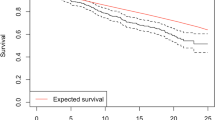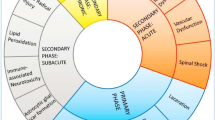Abstract
Introduction
Rigid cervical spine following trauma immobilization is recommended to reduce neurological disability and provide spinal stability. Soft collars have been proposed as a good alternative because of the complications related to rigid collars. The purpose of this study was to perform a systematic review on soft and rigid collars in the prehospital management of cervical trauma.
Method
A systematic review was performed following the PRISMA guidelines. Search terms were (immobilization) AND (collar) AND ((neck) OR (cervical)) to evaluate the range of motion (ROM) and evidence of clinical outcome for soft and rigid collars.
Results
A total of 18 studies met eligibility criteria including 2 clinical studies and 16 articles investigating the range of motion (ROM). Four hundred and ninety-six patients at a mean age of 32.5 years (SD 16.8) were included. Measurements were performed in a seated position in twelve studies. Eight articles reported the ROM without a collar, 7 with a soft collar, and 15 with a rigid collar. There was no significant difference in flexion/extension, bending and rotation following immobilization with soft collars compared to no collar. Rigid collars provided significantly higher stability compared to no collar (p < 0.005) and to soft collars in flexion/extension and rotation movements (p < 0.05). The retrospective clinical studies showed no significant differences in secondary spinal cord injuries for soft collar (0.5%) and for rigid collar (1.1%). One study, comparing immobilization without a collar compared to that with a rigid collar, found a significant difference in neurologic deficiency and supraclavicular nerve lesion.
Conclusion
Although rigid collars provide significant higher stability to no collar and to soft collars in flexion/ extension and rotation movements, clinical studies could not confirm a difference in neurological outcome.
Level of Evidence
II, Systematic Review.



Similar content being viewed by others
References
Sundstrom T, Asbjornsen H, Habiba S, Sunde GA, Wester K (2014) Prehospital use of cervical collars in trauma patients: a critical review. J Neurotrauma 31:531–540. https://doi.org/10.1089/neu.2013.3094
Chiu WC, Haan JM, Cushing BM, Kramer ME, Scalea TM (2001) Ligamentous injuries of the cervical spine in unreliable blunt trauma patients: incidence, evaluation, and outcome. J Trauma 50:457–463; discussion 464. https://doi.org/10.1097/00005373-200103000-00009
Hasler RM, Exadaktylos AK, Bouamra O, Benneker LM, Clancy M, Sieber R, Zimmermann H, Lecky F (2012) Epidemiology and predictors of cervical spine injury in adult major trauma patients: a multicenter cohort study. J Trauma Acute Care Surg 72:975–981. https://doi.org/10.1097/TA.0b013e31823f5e8e
Trauma ACoSCo (2012) Advanced Trauma Life Support (ATLS) Student Course Manual. In., Chicago, IL.
(PHTLS) PTLS (2010) Prehospital Trauma Life Support Committee of The National Association of Emergency Medical Technicians in Cooperation with The Committee on Trauma of The American College of Suregons. In. Jones & Bartlett Learning, Burlington, MA.
Davis JW, Phreaner DL, Hoyt DB, Mackersie RC (1993) The etiology of missed cervical spine injuries. J Trauma 34:342–346. https://doi.org/10.1097/00005373-199303000-00006
Kwan I, Bunn F, Roberts I (2001) Spinal immobilisation for trauma patients. Cochrane Database Syst Rev:CD002803. https://doi.org/10.1002/14651858.CD002803
Hauswald M, Braude D (2002) Spinal immobilization in trauma patients: is it really necessary? Curr Opin Crit Care 8:566–570. https://doi.org/10.1097/00075198-200212000-00014
Totten VY, Sugarman DB (1999) Respiratory effects of spinal immobilization. Prehosp Emerg Care 3:347–352. https://doi.org/10.1080/10903129908958967
Patterson H (2004) Emergency department intubation of trauma patients with undiagnosed cervical spine injury. Emerg Med J 21:302–305. https://doi.org/10.1136/emj.2003.006619
Deasy C, Cameron P (2011) Routine application of cervical collars—what is the evidence? Injury 42:841–842. https://doi.org/10.1016/j.injury.2011.06.191
Ham WH, Schoonhoven L, Schuurmans MJ, Leenen LP (2016) Pressure ulcers, indentation marks and pain from cervical spine immobilization with extrication collars and headblocks: an observational study. Injury 47:1924–1931. https://doi.org/10.1016/j.injury.2016.03.032
Nunez-Patino RA, Rubiano AM, Godoy DA (2020) Impact of cervical collars on intracranial pressure values in traumatic brain injury: a systematic review and meta-analysis of prospective studies. Neurocrit Care 32:469–477. https://doi.org/10.1007/s12028-019-00760-1
Stiell IG, Wells GA, Vandemheen KL, Clement CM, Lesiuk H, De Maio VJ, Laupacis A, Schull M, McKnight RD, Verbeek R, Brison R, Cass D, Dreyer J, Eisenhauer MA, Greenberg GH, MacPhail I, Morrison L, Reardon M, Worthington J (2001) The Canadian C-spine rule for radiography in alert and stable trauma patients. JAMA 286:1841–1848. https://doi.org/10.1001/jama.286.15.1841
Vaillancourt C, Charette M, Kasaboski A, Maloney J, Wells GA, Stiell IG (2011) Evaluation of the safety of C-spine clearance by paramedics: design and methodology. BMC Emerg Med 11:1. https://doi.org/10.1186/1471-227X-11-1
Resuscitation AaNZCo (2016) Guideline 9.1.6—Management of suspected spinal injury
Service QA (2017) Clinical practice procedures: Trauma/Cervical Collar. https://www.ambulance.qld.gov.au/docs/clinical/cpp/CPP_Cervical%20collar.pdf.
Innovation AfC (2020) Use of Foam Collars for Cervical Spine Immobilisation- Initial Management Principles. https://www.aci.health.nsw.gov.au/get-involved/institute-of-trauma-and-injury-management/clinical/trauma-guidelines/Guidelines/use-of-foam-collars-for-cervical-spine-immobilisation-initial-management-principles.
Zideman DA, De Buck ED, Singletary EM, Cassan P, Chalkias AF, Evans TR, Hafner CM, Handley AJ, Meyran D, Schunder-Tatzber S, Vandekerckhove PG (2015) European resuscitation council guidelines for resuscitation 2015 Section 9. First Aid Resuscitation 95:278–287. https://doi.org/10.1016/j.resuscitation.2015.07.031
Resuscitation AaNZCo (2017) ANZCOR Guideline 9.1.6—Management of Suspected Spinal Injury. http://resus.org.au/wpfbfile/anzcor-guideline-9-1-6-spinal-jan16-pdf/.
Moher D, Liberati A, Tetzlaff J, Altman DG, Group P (2009) Preferred reporting items for systematic reviews and meta-analyses: the PRISMA statement. PLoS Med 6:e1000097. https://doi.org/10.1371/journal.pmed.1000097
Ivancic PC (2013) Effects of orthoses on three-dimensional load-displacement properties of the cervical spine. Eur Spine J 22:169–177. https://doi.org/10.1007/s00586-012-2552-0
Conrad BP, Rechtine G, Weight M, Clarke J, Horodyski M (2010) Motion in the unstable cervical spine during hospital bed transfers. J Trauma 69:432–436. https://doi.org/10.1097/TA.0b013e3181e89f58
Asha SE, Curtis K, Healy G, Neuhaus L, Tzannes A, Wright K (2021) Neurologic outcomes following the introduction of a policy for using soft cervical collars in suspected traumatic cervical spine injury: a retrospective chart review. Emerg Med Australas 33:19–24. https://doi.org/10.1111/1742-6723.13646
Lin HL, Lee WC, Chen CW, Lin TY, Cheng YC, Yeh YS, Lin YK, Kuo LC (2011) Neck collar used in treatment of victims of urban motorcycle accidents: over- or underprotection? Am J Emerg Med 29:1028–1033. https://doi.org/10.1016/j.ajem.2010.06.003
Barati K, Arazpour M, Vameghi R, Abdoli A, Farmani F (2017) The effect of soft and rigid cervical collars on head and neck immobilization in healthy subjects. Asian Spine J 11:390–395. https://doi.org/10.4184/asj.2017.11.3.390
Ghorbani F, Kamyab M, Azadinia F, Hajiaghaei B (2016) Open-design collar vs. conventional philadelphia collar regarding user satisfaction and cervical range of motion in asymptomatic adults. Am J Phys Med Rehabil 95:291–299. https://doi.org/10.1097/PHM.0000000000000374
Carter VM, Fasen JA, Roman JM Jr, Hayes KW, Petersen CM (1996) The effect of a soft collar, used as normally recommended or reversed, on three planes of cervical range of motion. J Orthop Sports Phys Ther 23:209–215. https://doi.org/10.2519/jospt.1996.23.3.209
Hostler D, Colburn D, Seitz SR (2009) A comparison of three cervical immobilization devices. Prehosp Emerg Care 13:256–260. https://doi.org/10.1080/10903120802706195
Miller CP, Bible JE, Jegede KA, Whang PG, Grauer JN (2010) Soft and rigid collars provide similar restriction in cervical range of motion during fifteen activities of daily living. Spine (Phila Pa 1976) 35:1271–1278. https://doi.org/10.1097/BRS.0b013e3181c0ddad
Holla M (2012) Value of a rigid collar in addition to head blocks: a proof of principle study. Emerg Med J 29:104–107. https://doi.org/10.1136/emj.2010.092973
McGrath T, Murphy C (2009) Comparison of a SAM splint-molded cervical collar with a Philadelphia cervical collar. Wilderness Environ Med 20:166–168. https://doi.org/10.1580/08-WEME-BR-220R1.1
Porter A, Difrancesca M, Slack S, Hudecek L, McIntosh SE (2019) Improvised vs standard cervical collar to restrict spine movement in the backcountry environment. Wilderness Environ Med 30:412–416. https://doi.org/10.1016/j.wem.2019.07.002
James CY, Riemann BL, Munkasy BA, Joyner AB (2004) Comparison of cervical spine motion during application among 4 rigid immobilization collars. J Athl Train 39:138–145
Chi CH, Wu FG, Tsai SH, Wang CH, Stern SA (2005) Effect of hair and clothing on neck immobilization using a cervical collar. Am J Emerg Med 23:386–390. https://doi.org/10.1016/j.ajem.2005.02.006
Whitcroft KL, Massouh L, Amirfeyz R, Bannister GC (2011) A comparison of neck movement in the soft cervical collar and rigid cervical brace in healthy subjects. J Manipulative Physiol Ther 34:119–122. https://doi.org/10.1016/j.jmpt.2010.12.007
Graziano AF, Scheidel EA, Cline JR, Baer LJ (1987) A radiographic comparison of prehospital cervical immobilization methods. Ann Emerg Med 16:1127–1131. https://doi.org/10.1016/s0196-0644(87)80469-9
Tescher AN, Rindflesch AB, Youdas JW, Jacobson TM, Downer LL, Miers AG, Basford JR, Cullinane DC, Stevens SR, Pankratz VS, Decker PA (2007) Range-of-motion restriction and craniofacial tissue-interface pressure from four cervical collars. J Trauma 63:1120–1126. https://doi.org/10.1097/TA.0b013e3180487d0f
Cline JR, Scheidel E, Bigsby EF (1985) A comparison of methods of cervical immobilization used in patient extrication and transport. J Trauma 25:649–653. https://doi.org/10.1097/00005373-198507000-00013
Hussain MH, Corsar K (2019) Semirigid cervical spine collar and risk of missing significant soft tissue injuries. BMJ Case Rep 12. https://doi.org/10.1136/bcr-2018-228761
Barkana Y, Stein M, Scope A, Maor R, Abramovich Y, Friedman Z, Knoller N (2000) Prehospital stabilization of the cervical spine for penetrating injuries of the neck—is it necessary? Injury 31:305–309. https://doi.org/10.1016/s0020-1383(99)00298-3
Ottosen CI, Steinmetz J, Larsen MH, Baekgaard JS, Rasmussen LS (2019) Patient experience of spinal immobilisation after trauma. Scand J Trauma Resusc Emerg Med 27:70. https://doi.org/10.1186/s13049-019-0647-x
Ozdogan S, Gokcek O, Katirci Y, Corbacioglu SK, Emektar E, Cevik Y (2019) The effects of spinal immobilization at 20 degrees on intracranial pressure. Am J Emerg Med 37:1327–1330. https://doi.org/10.1016/j.ajem.2018.10.010
Ireland CJ, Zeitz KM, Bridgewater FH (2008) Acquiring and maintaining competence in the application of extrication cervical collars by a group of first responders. Prehosp Disaster Med 23:530–536. https://doi.org/10.1017/s1049023x00006373
Lerner EB, Moscati R (2000) Duration of patient immobilization in the ED. Am J Emerg Med 18:28–30. https://doi.org/10.1016/s0735-6757(00)90043-3
Drain J, Wilson ES, Moore TA, Vallier HA (2020) Does prehospital spinal immobilization influence in hospital decision to obtain imaging after trauma? Injury 51:935–941. https://doi.org/10.1016/j.injury.2020.02.097
McDonald N, Kriellaars D, Weldon E, Pryce R (2021) Head-neck motion in prehospital trauma patients under spinal motion restriction: a pilot study. Prehosp Emerg Care 25:117–124. https://doi.org/10.1080/10903127.2020.1727591
Thezard F, McDonald N, Kriellaars D, Giesbrecht G, Weldon E, Pryce RT (2019) Effects of spinal immobilization and spinal motion restriction on head-neck kinematics during ambulance transport. Prehosp Emerg Care 23:811–819. https://doi.org/10.1080/10903127.2019.1584833
Hammacher ER, van der Werken C (1996) Acute neck sprain: "whiplash’ reappraised. Injury 27:463–466. https://doi.org/10.1016/0020-1383(96)00064-2
Ricciardi L, Stifano V, D’Arrigo S, Polli FM, Olivi A, Sturiale CL (2019) The role of non-rigid cervical collar in pain relief and functional restoration after whiplash injury: a systematic review and a pooled analysis of randomized controlled trials. Eur Spine J 28:1821–1828. https://doi.org/10.1007/s00586-019-06035-9
Kornhall DK, Jorgensen JJ, Brommeland T, Hyldmo PK, Asbjornsen H, Dolven T, Hansen T, Jeppesen E (2017) The Norwegian guidelines for the prehospital management of adult trauma patients with potential spinal injury. Scand J Trauma Resusc Emerg Med 25:2. https://doi.org/10.1186/s13049-016-0345-x
Prasarn ML, Hyldmo PK, Zdziarski LA, Loewy E, Dubose D, Horodyski M, Rechtine GR (2017) Comparison of the vacuum mattress versus the spine board alone for immobilization of the cervical spine injured patient: a biomechanical cadaveric study. Spine (Phila Pa 1976) 42:E1398–E1402. https://doi.org/10.1097/BRS.0000000000002260
Maschmann C, Jeppesen E, Rubin MA, Barfod C (2019) New clinical guidelines on the spinal stabilisation of adult trauma patients—consensus and evidence based. Scand J Trauma Resusc Emerg Med 27:77. https://doi.org/10.1186/s13049-019-0655-x
Thorvaldsen NO, Flingtorp LD, Wisborg T, Jeppesen E (2019) Implementation of new guidelines in the prehospital services: a nationwide survey of Norway. Scand J Trauma Resusc Emerg Med 27:83. https://doi.org/10.1186/s13049-019-0660-0
Stanton D, Hardcastle T, Muhlbauer D, van Zyl D (2017) Cervical collars and immobilisation: a South African best practice recommendation. Afr J Emerg Med 7:4–8. https://doi.org/10.1016/j.afjem.2017.01.007
Morrissey JF, Kusel ER, Sporer KA (2014) Spinal motion restriction: an educational and implementation program to redefine prehospital spinal assessment and care. Prehosp Emerg Care 18:429–432. https://doi.org/10.3109/10903127.2013.869643
Acknowledgement
We would like to thank Robert Röhle, M.Sc. at the Charité Berlin, University Hospital Berlin, Germany, for his help with the meta-analysis.
Funding
None.
Author information
Authors and Affiliations
Corresponding author
Ethics declarations
Conflict of interest
The authors declare that they do not have any conflict of interest.
Ethical consent
No ethical approval was required.
Additional information
Publisher's Note
Springer Nature remains neutral with regard to jurisdictional claims in published maps and institutional affiliations.
Rights and permissions
Springer Nature or its licensor holds exclusive rights to this article under a publishing agreement with the author(s) or other rightsholder(s); author self-archiving of the accepted manuscript version of this article is solely governed by the terms of such publishing agreement and applicable law.
About this article
Cite this article
Bäcker, H.C., Elias, P., Braun, K.F. et al. Cervical immobilization in trauma patients: soft collars better than rigid collars? A systematic review and meta-analysis. Eur Spine J 31, 3378–3391 (2022). https://doi.org/10.1007/s00586-022-07405-6
Received:
Revised:
Accepted:
Published:
Issue Date:
DOI: https://doi.org/10.1007/s00586-022-07405-6




